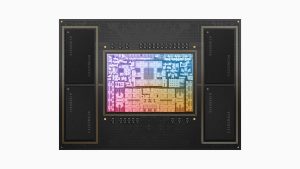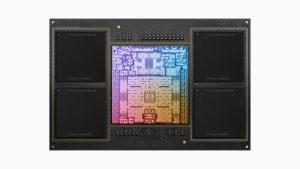Apple introduced MacBooks using its latest proprietary PC chipsets. Apple claims the M2 Pro and M2 Max chipsets provide “industry-leading” power efficiency, a faster CPU and GPU, and up to 96 GB of unified memory.
The second-generation 5-nanometer M2 Pro has 40 billion transistors, about 20% more than the M1 Pro and double the amount in M2, 200 GB of unified memory bandwidth, and up to 32 GB of low-latency unified memory. The 10- or 12-core CPU contains up to eight high-performance cores and four high-efficiency cores, resulting in multithreaded CPU performance up to 20% faster than the 10-core CPU in M1 Pro. It may be configured with up to 19 GPU cores, three more than the M1 Pro, and a larger L2 cache.

Apple M2 Pro – Photo Credit: Apple
Apple claims that the M2 Pro compiles Xcode 2.5x quicker than the fastest Intel-based MacBook Pro and has 30% faster graphics than the M1 Pro.
The M2 Max, the more powerful chipset, contains 67 billion transistors, 10 billion more than M1 Max and 3x that of M2, and 400 GB of unified memory bandwidth, supporting up to 96 GB of rapid unified memory. It has the same 12-core CPU as M2 Pro, a bigger L2 cache, and a 38-core GPU.

Apple M2 Max – Photo Credit: Apple
Apple claims 30% quicker graphics over M1 Max. The M2 Max has the longest Mac battery life at 22 hours.
Apple’s 16-core Neural Engine and Secure Enclave protect the M2 Pro and M2 Max’s key management. The Neural Engine accelerates video analysis, voice recognition, picture processing, and camera image quality.
Media processing differs amongst chipsets. According to Apple, the M2 Max contains two video encoding engines and two ProRes engines, enabling up to 2x quicker video encoding than the M2 Pro.